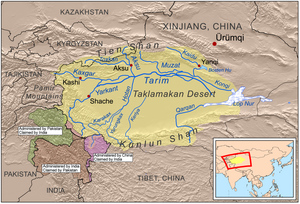Karasahr
| Author:Laxman Burdak, IFS (Retd.) |

Karasahr or Karashar or Yanqi (Chinese: 焉耆; pinyin: Yānqí; Wade–Giles Yen-ch’i; Sanskrit: अग्निदेश Agnideśa), meaning 'black city' in Uyghur languages, is an ancient town on the Silk Road and the capital of Yanqi Hui Autonomous County in the Bayin'gholin Mongol Autonomous Prefecture, Xinjiang, in northwestern China.
Location
The modern town of Yanqi is situated about 24 kms west of the shallow Lake Bosten. The town is well connected, being located on the Kaidu River (known in ancient times as the Liusha), China National Highway 314 and the Southern Xinjiang Railway, and is an important material distribution center and regional business hub. The town administers ten communities.
The ancient state bordered Kucha and thence Aksu to the west, and Turpan to the east. To the south, via Korla, and across the desert, was Khotan.
The town has a notable Islamic population and contains many mosques.
Origin of name
The Buddhist Sanskrit name for the town was 'Agni' or 'Fire.' "Yanqi, it seemed, was the local derivation of yanghi, the Turkic word for fire. The city had possibly once been called Yanghi-shaher or Fire City. Xuanzang, a stickler for precision and partial to India, had used the Sanskrit word for fire, agni, and transliterated this into Chinese, yielding 'O-ki-ni."[1]
Visit by Xuanzang in 630 AD
- Xuanzang persuaded some Buddhist guards at Yumen Pass and slipped out of the empire through Liangzhou (Gansu) and Qinghai in 629.[2]
- He subsequently travelled across the Gobi Desert to Kumul (modern Hami City), thence following the Tian Shan westward, arriving in Turpan in 630. Here he met the king of Turpan, a Buddhist who equipped him further for his travels with letters of introduction and valuables to serve as funds.
- Moving further westward, Xuanzang escaped robbers to reach Karasahr, then toured the non-Mahayana monasteries of Kucha.
History
The Kingdom of Yanqi (Karashar) was an ancient Buddhist kingdom located on the branch of the Silk Route that ran along the northern edge of the Taklamakan Desert in the Tarim Basin. During the Han dynasty it was a relatively large and important kingdom. According to Book of Han, the various states of the Western Regions, including Yanqi, were controlled by the nomadic Xiongnu, but later came under the influence of the Han dynasty after its show of force when it attacked Dayuan (Fergana) in the late 2nd century BC.[3]
According to the Book of the Later Han, General Ban Chao went on a punitive campaign against Yanqi in 94 AD after they attacked and killed the Protector General Chen Mu and Vice Commandant Guo Xun in 75 AD. The king of Yanqi was decapitated and his head displayed in the capital. Later rebellions were subdued by Ban Chao's son Ban Yong in 127.
In 644, during the Tang expansion into the Tarim Basin, Emperor Taizong of Tang launched a military campaign against Yanqi after the kingdom allied itself with the Turks. The Four Garrisons of Anxi was established with one based at Yanqi.
Karashahr become known to Europeans as Cialis-an Italianized transcription of the Turkic Chalis)[5]-in the early 17th century, when the Portuguese Jesuit Lay Brother Bento de Góis visited it on his way from India to China (via Kabul and Kashgar). De Góis and his traveling companions spent several months in the "Kingdom of Cialis", while crossing it with a caravan of Kashgarian merchants (ostensibly, tribute bearers) on their way to Ming China. The travelers stayed in Cialis City for three months in 1605, and then continued, via Turpan and Hami (all parts of the "Kingdom of Cialis", according to de Góis), to the Ming border at Jiayuguan.[4][5][6]
External sources
References
- ↑ Saran (2005), p. 61.
- ↑ Note sur la chronologie du voyage de Xuanzang." Étienne de la Vaissière. Journal Asiatique, Vol. 298, 1. (2010), pp. 157-168.[1]
- ↑ Hulsewé, A. F. P. (1979). China in Central Asia: The Early Stage 125 BC – AD 23: an annotated translation of chapters 61 and 96 of the History of the Former Han Dynasty. E. Brill, Leiden. pp. 73–80. ISBN 90-04-05884-2.
- ↑ "Bento de Goes", in: Goodrich, Luther Carrington; Fang, Zhaoying (1976). Dictionary of Ming biography, 1368–1644. Volume 1. Columbia University Press. pp. 472–473. ISBN 0-231-03801-1.
- ↑ Dughlt, Mirza Muhammad Haidar (2008). A History of the Moghuls of Central Asia: The Tarikh-I-Rashidi. Cosimo, Inc. ISBN 1-60520-150-2.
- ↑ Trigault, Nicolas S. J. "China in the Sixteenth Century: The Journals of Mathew Ricci: 1583–1610". English translation by Louis J. Gallagher, S.J. (New York: Random House, Inc. 1953). This is an English translation of the Latin work, De Christiana expeditione apud Sinas based on Matteo Ricci's journals completed by Nicolas Trigault. Book Five, Chapter 12, "Cathay and China Proved to Be Identical", pp. 510-513. There is also full Latin text available on Google Books.

